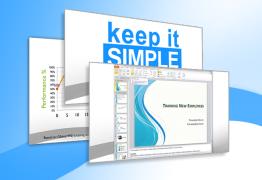Giving Engaging Digital Presentations
Do you feel that your slide presentation is going over the head of your students? Does your class spend more time copying down your slides than paying attention to you? When done well, slide-based presentations can be an important part of how students perceive and retain information. However, slides can also distract, detract, and intrude on the importance of the speaker's message. Fear not, giving engaging presentation can be a matter of considering some basic guidelines that have been suggested, fine-tuned, and used in academic and corporate settings. Here are a few tips to consider when trying to convey course material in a clear and attention-grabbing way.
#1 You are the lecture, not the slides.
Slide-based presentations are a great way to organize your thoughts and convey them to your students. But they can also be a crutch. While it is tempting to build your lecture around your slide show, the end result may be a lecture experience that could have been obtained by printing out the slides and reading them at home. Instead, remember that you are giving the lecture, not the slides. Develop your lectures first and then incorporate them into slides that support the lecture. A good way to determine if your lecture is too slide-focused is to consider whether or not you could give your lecture without the slides. If you could not, you may want to go back to the beginning and start over. Similarly, once you are in class, engage your students by facing them rather than turning around and reading your slides. And just as the slides should reinforce what you say, you can verbally reinforce some of the key words that are up on the screen.
#2 Create context.
Before you begin creating slides, consider organizing them into a master outline. This way you can ensure that you are covering the main points in an organized manner. You will want each slide to cover a main point which you will then be expand upon further. Summary slides are a good way to recap where you have been and where you are going.
#3 Keep it simple.
It is tempting to want to cram a lot of information into one slide so that nothing is left out. Some instructors even put all their notes in one slide and then read directly from them. However, your students are more likely to absorb information if you use the slides to reinforce the most important points. One useful approach is to view each bullet as one key idea. Some presenters subscribe to the "7-6-5" rule which imposes a limit of seven words per line, six lines per slide, and five content-heavy slides in a row. If you find that you can not convey all the info you need to within these constraints, consider providing a handout or hyperlink to your students for the more detailed subjects. Likewise, animations, sounds, and transitions can add style to a presentations, but they can just as easily detract if they are used to often or are distracting.
#4 Keep it clean.
You don't have to be a graphic designer to make stylish looking slides. Where some presenters go wrong is by introducing too many images, fonts, and colors that create a cluttered feel. When in doubt, use simple, primary colors rather than neons or pastels. If you would like to enhance your slides with images, try to stick to pictures that are relevant and reinforce the content of your slide. Avoid using clip art or images that are too cartoon-like.
A Google image search is a great way to quickly search the web. Try searching for png or jpg files, which will show up nicely in a slide show. You will want to maintain the proper resolution and avoid stretching or scaling down when pasting them into a slide.
When choosing a font, use readable fonts, such as arial, big caslon, helvetica, or bookman. Where possible, try to limit the use of numbers and intervals.
#5 Be consistent.
Nothing can be more confusing than slides that look like they belong to different presentations. If you use titles for some slides, consider using it for all slides. It will help your students keep track of where they are in the lecture. Consider creating a template that you can reuse for each slide in a lecture, or even for all lectures in a course. Rutgers offers pre-made, downloadable PowerPoint templates. Creating a slide master is also a great way to achieve consistency without editing each slide you make. Aside from your template, also remember consistency when adding fonts, animations, and transitions.
Additional Reading
Take a look at the following links for some more suggestions:
- Great Presentations: Tips from Great Presenters
- Tips for Effective Presentations
- 15 Strategies for Giving Oral Presentations
- About.com's Presentation Software page
For a live demonstration of these tips and more, watch for our Giving Engaging Digital Presentations workshop. For information about presentation alternatives to PowerPoint, read our Beyond PowerPoint article.
